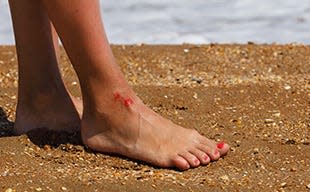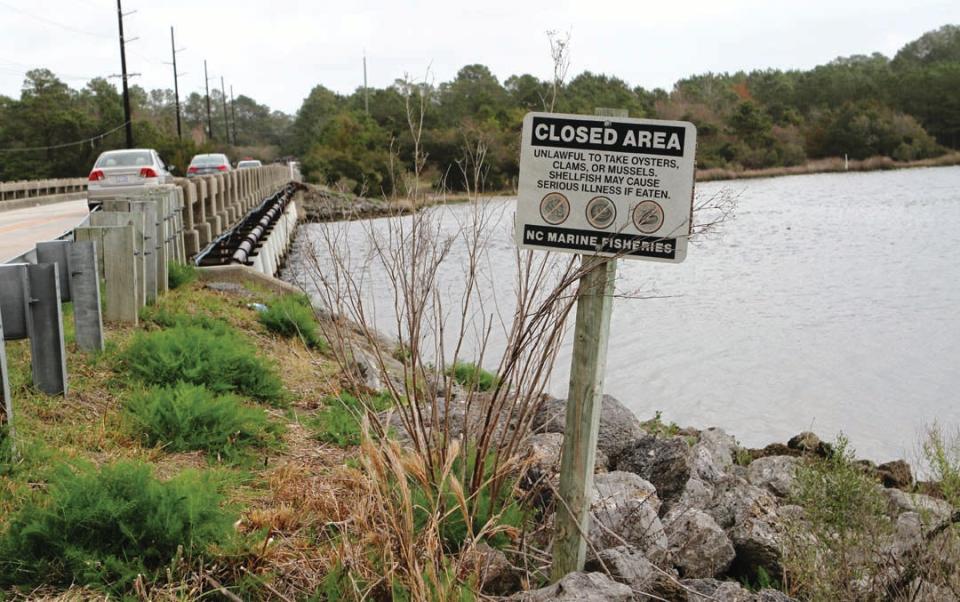A warming ocean is helping a flesh-eating bacteria creep north. What it means for the NC coast.

When Hurricane Lee rapidly grew in strength and size last week, following a pattern established by Hurricanes Idalia earlier this year and Ian last year, rising ocean temperatures were fingered as a major reason for the storm's intensification.
As greenhouse gases associated with climate change warm the atmosphere, the oceans are absorbing more heat, resulting in an increase in sea surface temperatures and rising sea levels. That, in turn, is allowing tropical storms to draw more energy from the water, leading to more dangerous hurricanes that can cause more damage along the coast and carry those dangerous winds and rains much farther north into territory that rarely sees hurricanes, like New England and the Canadian Maritimes, and much deeper inland.
But another impact from the warming oceans has scientists and health officials, especially along the Mid-Atlantic and New England coasts, concerned.
Earlier this month, the Centers for Disease Control and Prevention (CDC) issued a health alert over rising cases of Vibrio vulnificus, a flesh-eating bacterium associated with warming coastal waters.
"Amid increasing water temperatures and extreme weather events (e.g., heat waves, flooding, and severe storms) associated with climate change, people who are at increased risk for V. vulnificus infection should exercise caution when engaging in coastal water activities," the alert states. "Prompt treatment is crucial to reduce mortality from severeV. vulnificus infection."
WEATHER WOES Study says climate change could impact the rapid growth along the NC, SC coasts
The CDC notes that since July three East Coast states − New York, Connecticut and North Carolina − have reported severe and fatal V. vulnificus infections. In a July 28 release, the N.C. Department of Health and Human Services (DHHS) issued its own warning about swimming in coastal waters with wounds or open cuts after the state reported three deaths this summer from Vibrio infections.
Vibrio infections can be treated easily if people get antibiotics quickly. But without quick attention, they can cause necrotizing fasciitis, better known as flesh-eating disease. According to the CDC, many people infected with V. vulnificus require intensive care or surgical tissue removal, even amputation.
"This can be a pretty serious, nasty infection," said Dr. Larry Cahoon, a marine biologist at the University of North Carolina Wilmington. "You don't want to wait until your whole leg is swelling and you're running a fever to seek treatment."
What is Vibrio vulnificus?
Vibrioare bacteria that cause an estimated 80,000 illnesses each year in the U.S., with about a dozen species of the bacteria pathogenic to humans, according to the CDC.
Symptoms of a Vibrio infection include diarrhea, with stomach cramping, nausea, vomiting, fever, and chills also common ailments. ButV. vulnificus, is known to cause life-threatening infections. The CDC said roughly 150 to 200 V. vulnificus infections are reported to the federal agency each year, although that's considered a significant undercount, with about one in five people dying within 1-2 days of becoming ill.
SUPER-CHARGED STORMS A warming planet is pushing hurricanes north and deeper inland. What that means for NC
Most people get sick from Vibrio by eating raw or undercooked shellfish, particularly oysters. With oysters a multi-million dollar business in many states, including North Carolina, federal and state regulators tightly monitor oyster waters to make sure contaminated bivalves doesn't enter the food chain. That includes closing waters to oysters fishing and farming that are known to be prone to pollutants like fecal coliform. Among the best antidotes to Vibrio is cold water temperatures − hence, one of the reasons for the old rule of thumb that you only eat oysters in months ending in "r."
Although the CDC says V. vulnificus can be transmitted through tainted seafood, the bacteria is primarily transmitted to humans through open-wound contact with salt water or brackish water. The elderly or those with weakened immune systems are especially vulnerable to catching an infection.
Cahoon said the bacteria loves hanging around in the sediments in coastal waters and tidal creeks where there's plenty of organic matter to feed on but not much sunlight and generally not very salty brackish waters.
"What that means is you're generally going to be fine swimming or wading on the beachside of our barrier islands," he said. "But doing that in the estuaries, especially if you have an open wound or cut, is a different matter."
Why the growing concern?
Vibrio occurs naturally in areas with warm water and low-salt environments. The warmer the water, the more the bacteria thrives.
But while it has always been a concern in areas like the Gulf and in the waters around Florida, the bacteria's range has been expanding as ocean waters warm up. According to the CDC, V. vulnificus infections in the Eastern U.S. increased eightfold from 1988 to 2018, and the geographic range of infections has been marching north 30 miles per year.
RISING WATERS New studies show 'unprecedented' sea-level rise along the North Carolina coast
This summer, Vibrio killed three people and sickened a fourth in Connecticut and New York, several of them contracting the pathogen after swimming in Long Island Sound. Since 2019, eight of the 47 reported Vibrio cases among North Carolina residents have been fatal, including three this year, according to DHHS.
According to NOAA's National Centers for Environmental Information, water temperatures on Tuesday were 79.5 degrees at Wilmington's Cape Fear Memorial Bridge and 83.7 at a buoy 225 nautical miles south of Cape Hatteras. That compares to normals of 78.5 and 82.3 degrees, respectively.
"As climate change increases water temperatures, more Vibrio cases can be expected, and they are likely to be identified in previously unaffected areas," states the DHHS release.

What happens now?
With ocean temperatures expected to keep rising in coming years, officials are eager to get out the word about to health professionals and residents in areas where they might not be familiar with Vibrio about the potential danger posed by the bacteria.
In its alert, the CDC emphasized to health professionals how fast Vibrio infections can turn septic and to send cultures to a lab an do other testing just to be on the safe side. But the agency also urged doctors to start patients on antibiotics immediately, without waiting for lab results or consultation with a specialist.
While the Carolinas used to be considered near the northern most extent of Vibrio's range, the bacteria has now been found in the Chesapeake Bay and is believed to be successfully overwintering in North Carolina − in part because rapid population growth is filling coastal waters with nutrients that help the bacteria survive and thrive along with the warming water temperatures.
Cahoon said additional education and outreach efforts in the coming years will likely be needed to reach people in areas where Vibrio isn't a known problem because it's highly unlikely the bacterium's march north will stop anytime soon unless climate change is slowed, and recent human actions make that highly unlikely.
“We’ve seen a dramatic warming or our waters this year," he said, noting some ocean temperatures off Florida reached more than 100 degrees in July. "While some is associated with El Niño, some was already occurring in the North Atlantic basin, so it's probably part of a larger trend. But we can confidently predict an overall trend of warming ocean temperatures."
According to the DHHS, following these recommendations will help reduce your likelihood of Vibrio exposure and infection:
If you have a wound (including from a recent surgery, piercing or tattoo), stay out of saltwater or brackish water, if possible. This includes wading at the beach.
Cover your wound with a waterproof bandage if it could come into contact with saltwater, brackish water or raw or undercooked seafood.
If you sustain any type of wound while in salt or brackish water (e.g., cutting your hand on a boat propeller or crab pot) immediately get out of the water and wash with soap and water.
Wash wounds and cuts thoroughly with soap and water after contact with saltwater, brackish water or raw seafood.
Thoroughly cook all shellfish to an internal temperature of at least 145 degrees Fahrenheit for 15 seconds, according to the U.S. Department of Agriculture.
Reporter Gareth McGrath can be reached at GMcGrath@Gannett.com or @GarethMcGrathSN on Twitter. This story was produced with financial support from 1Earth Fund and the Prentice Foundation. The USA TODAY Network maintains full editorial control of the work.
This article originally appeared on Wilmington StarNews: Flesh-eating bacteria in NC coast warming ocean temps Vibrio vulnificus

